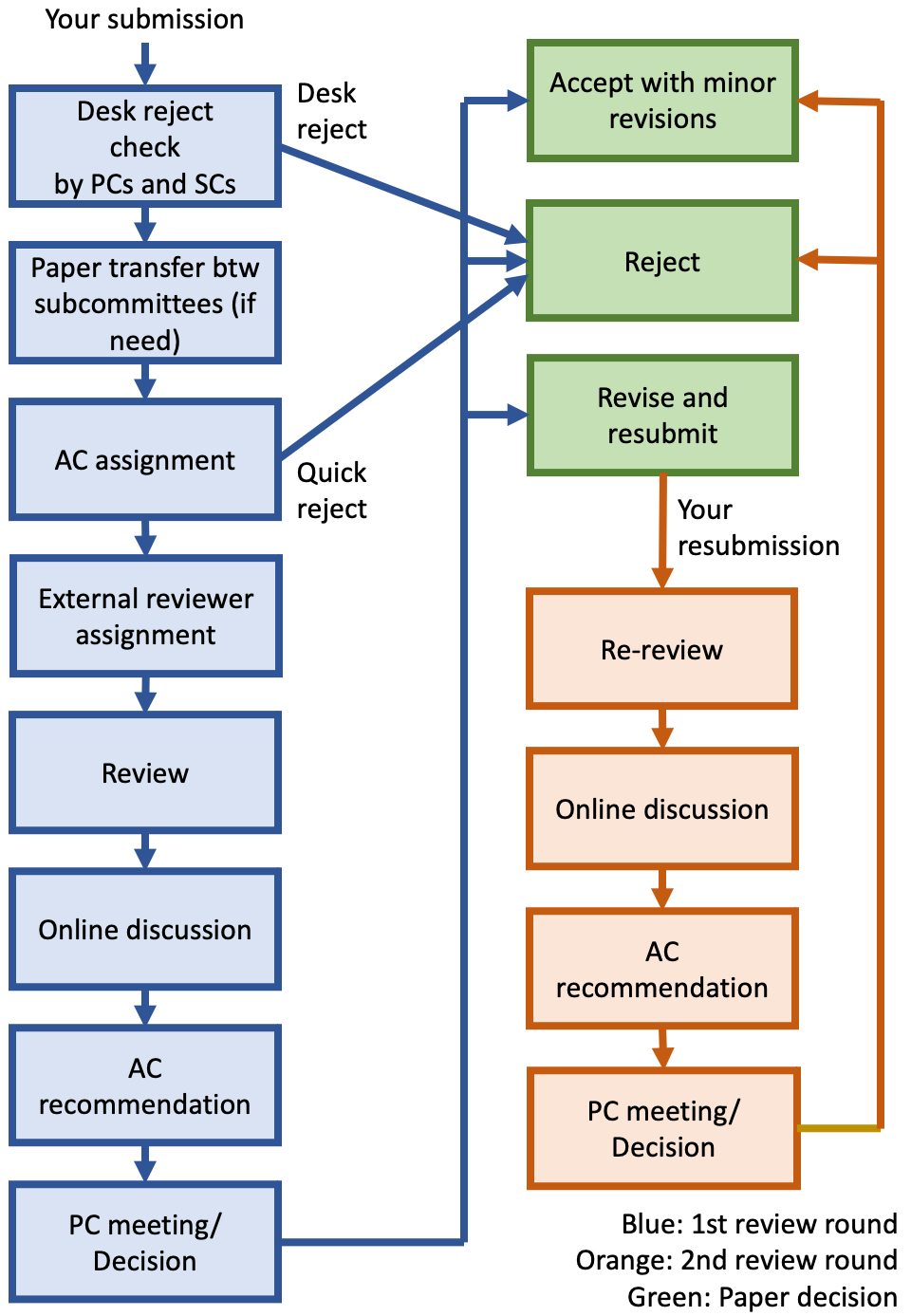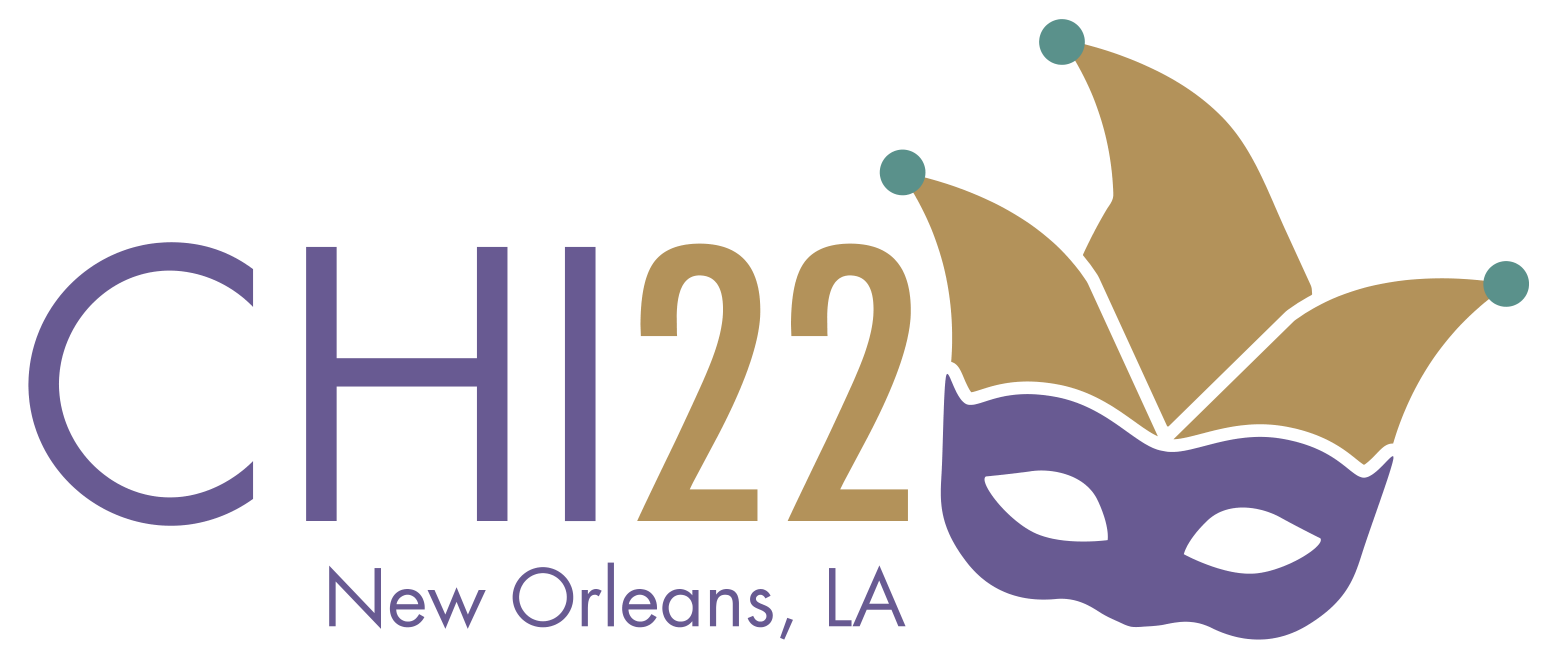Papers Review Process
Process Overview

Desk Reject
Upon initial submission, the Papers chairs (PCs) and Subcommittee chairs (SCs) will determine whether the submission is appropriate for CHI or should be desk rejected. Desk rejects are made to save our reviewers’ time.
Examples of desk rejects are:
- Incomplete submissions.
- The paper lacks anonymization.
- Leaving the author names in the paper or having a description or an acknowledgements section that reveals authors or the institution (e.g. places where user studies were conducted and specific supporting grant information).
- Failure of declaration of concurrent submissions that are closely related to the submission.
- If you have such a submission, you must include an anonymized version of that submission as a supplementary material. The same rule applies if your submission is built directly on a project described in a paper that is unpublished or currently under review at other venues.
- Failure of declaration and/or citation of authors’ prior publications that are closely related to the submission.
- Make sure you cite your prior publications by following our Anonymization Policy.
- Use of wrong formats.
- All submissions must use the template specified in the Call for Submissions page. Note that CHI has used the single-column format since 2021, and submissions with other templates including double-column and extended abstracts will be desk rejected.
- Clearly out of scope for the conference (e.g. formal methods for interstellar microcontrollers).
- Not written in English.
- Obviously not a conference paper (patent disclosure, popular press article, a complete book, etc.).
- Something is so broken in the paper that makes it impossible to review.
Desk rejected submissions will not be assigned to a reviewer, and their authors will receive a brief note about the rejection.
Subcommittee and AC Assignment
For the submissions that are not desk rejected, SCs will check whether each of them has been submitted to an appropriate subcommittee with sufficient expertise to review. In rare cases, SCs will transfer papers that were initially assigned to their subcommittee to the secondary subcommittee chosen by the authors for more appropriate reviews. In a very exceptional case where the two subcommittees chosen by authors do not have the right expertise to assess the submission, the PCs will move it to another subcommittee.
All SCs and ACs are instructed to declare their conflicts of interests based on institutions and previous collaborations during the paper bidding phase. ACs are also instructed to express their preferences (or bids) on which submissions they would like to review. In this bidding phase, the title and abstract are the central information resources for ACs to identify submissions they prefer to review. Therefore, it is very important for authors to write titles and abstracts that clearly convey the core contributions of their submissions.
SCs will then perform paper assignments to Associate Chairs (ACs). ACs will be asked to complete paper bidding before this assignment so that their preferences and expertise are considered. Each submission will have two ACs, one as the primary AC (1AC) and the other as the secondary (2AC). 1AC is aware of the authors of the papers in order to best determine whether external reviewers are conflicted. The external reviewers are never aware of the authorship of papers. The identity of the authors is revealed to the secondary AC during the discussion phase of the process.
Quick Reject
The 1AC and 2AC will collaboratively check if a submission is a candidate for quick reject. The quick reject process entails considerable work for both ACs and SCs. Each paper will have at least 4 distinct, non-conflicted people (ACs, SCs, and PCs) that will have looked at any paper that is a potential quick reject, and all must agree that the paper would not have a chance of acceptance into the conference. The 1AC must first confer with the 2AC; come to an agreement and convince both SCs that the paper should be quick rejected. The paper will not require 2 external reviewers and thus decrease the overall load on the community. At this point, the 1AC must write up a sufficient and constructive review detailing why this paper is being quick rejected which must be acknowledged by the 2AC. This review will be checked by SCs.
This quick reject process sounds very harsh because it only provides a small amount of feedback. We brought it in because it allows us to offer rapid feedback to authors so that they can resubmit to other venues and also enables our reviewers to focus on submissions that have a high chance of improving and impacting the community.
Note that quick reject is NOT as easily determined by a few straightforward criteria, nor determined by a single person. Care is taken for a full justification of why this paper has not been reviewed by external reviewers. The burden on the ACs is particularly strong since they need to enter a complete and compelling review and the paper is still evaluated by both ACs and SCs (conflicts permitting).
The criteria for quick reject are:
- HCI contribution is much too small given the length of the submitted paper (we expect that papers would on average 6 to 18 pages in the new one column format). This criterion includes papers that are far too long, as if someone submitted a book manuscript. Since there is no strict paper length, this is a subjective criterion, however if authors attempt to submit papers that are clearly inappropriate for a conference submission (extended book chapters, unedited reports), then a paper may be quick rejected to prevent the undue burden on external reviewers.
- Grossly insufficient detail to replicate the apparatus or the experiment.
- Grossly insufficient data to validate the analysis to support the claim.
- Grossly insufficient literature review to contextualize and/or evaluate the proposed novelty/contribution to HCI in particular.
- Paper is very sloppy: lots of typos, missing references, formatting issues (including large white spaces).
Round 1 Review Process
The 1AC will manage the review process and recruit two external reviewers to assess each submission that undergoes full review. The 2AC will provide a full review like the external reviewers. External reviewers should have high expertise on the topic of the paper(s) they are asked to review. As part of the review process Papers Chairs and Subcommittee Chairs reserve the right to get additional input from other ACs for any paper so as to make the best decision for acceptance. External reviewers will be asked to provide a detailed review of the submission and will be asked to provide a first round, summary decision placing the paper into one of the following categories:
Accept with Minor Revisions: There are only minor changes required to make the submission suitable for publication. The 1AC is responsible for ensuring the changes are made before the paper is fully accepted for publication.
Revise and Resubmit: The 1AC and reviewers feel that there is potential for a publishable outcome for the submission, but not without major revisions to address issues enumerated by the reviewers.
Reject: The reviewers do not feel that either of the categories above is appropriate. Note that unlike typical journals, the time frame for the Revise and Resubmit process is limited, and will not allow authors to execute another extensive implementation and/or evaluation or perform complete rewrite. A submission will thus be rejected if the reviewers feel that the required revisions would not be achievable within this short time frame.
SCs will ensure that, for each paper, all ACs and external reviewers will confer asynchronously to determine the first round, summary judgement.
For submissions with the accept with minor revisions, authors must include minor revisions requested by the reviewers and submit by the 1st round camera ready deadline. 1AC will check the revised manuscript for final approval. In case revisions are not sufficient, 1AC will communicate with authors, and authors should respond quickly. Note that failure of addressing minor revision requests will result in the rejection of that submission.
Resubmission and Round 2 Review Process
Authors of the papers with the Revise and Resubmit decisions are invited to submit a revision of their submission by the resubmission deadline (see Important Dates). Revisions should use colors to highlight the changes to the document, and also include a response letter on how the reviewer comments have been addressed. The authors may communicate anonymously through the submission system with the 1AC for clarifications. If the 1AC does not respond, the authors should contact the PCs and SCs. No resubmission will be allowed after the deadline.
All the resubmissions will be reviewed by the original set of ACs and external reviewers. The 1AC reserves the right to invite new reviewers if needed. The results of the current review(s) and online discussions will be shared with the new reviewers in such cases. The result of the second round review is either Accept with Minor Revisions or Reject. Authors do not have a chance for another round of major revisions.
Final revisions for papers with the decisions of Accept with Minor Revisions (in both 1st and 2nd rounds) will be checked by the program committee (the 1AC with the help of other program committee members if needed), and a final decision will be made on each paper and communicated with the authors.

